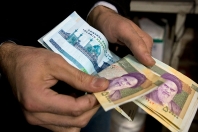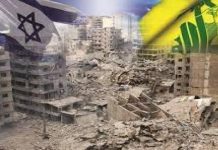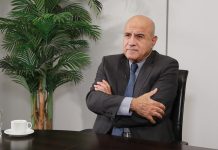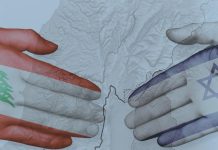
أين ستصرف رزمة ال 150 بليون دولار التي سيعطيها الاتفاق النووي لإيران الملالي
الياس بجاني/06 آب/15
من المستغرب في مفاهيم الغباء وعدم فهم طبيعة نظام الملالي الإرهابي والتوسعي والمذهبي القاتل إن من عقدوا الصفقة النووية مع ملاليها الدول الخمسة الدائمين العضوية مي مجلس الأمن مع ألمانيا، وفي مقدمهم الرئيس أوباما نفسه غير قادرين على تبليعه لشعوبهم ولشعوب العالم الحر ولا لأي دولة عربية أو شرق أوسطية وخصوصاً لدولة إسرائيل. ومن مهازل الاتفاق الاستسلامي والتخاذلي قال أمس الرئيس الأميركي اوباما إن هذه البلايين سوف يستعملها الملالي في زيادة تمويلهم لكل أنشطتهم ومخططاتهم الإرهابية والتوسعية والتخريبية، وفي النفس الوقت نراه يسوّق بقوة لتمرير الاتفاق الخطيئة هذا. هنا لا بد من رفع القبعة احتراماً لإصرار رئيس وزراء إسرائيل نيتانياهو على معارضته الاتفاق وعلى عملة الدؤوب الهادف إلى اقناع مجلسي الشيوخ والنواب الأميركيين بعدم المموافقة عليه ورفضه، في نفس الوقت من المحزن والمستغرب أن لم ترقى المعارضة العربية له هذا الوضوح والقوة الإسرائيليين.
في أسفل تحليل سياسي لعدد من كبار المحللين الستراتجيين يبينون بالتفصيل الموثق على من وكيف ستصرف إيران البلايين ال150.
The Regional Impact of Additional Iranian Money
Michael Eisenstadt, Simon Henderson, Michael Knights, Matthew Levitt, and Andrew J. Tabler/Washington Institute/05 August/15
First posted on July 28, 2015
A post-sanctions windfall would give Tehran ample capacity to rescue the Syrian regime, reshape Iraq’s political environment, expand its terrorist proxy activities in various theaters, and otherwise amplify the effects of its destabilizing regional posture. If the Joint Comprehensive Plan of Action (JCPOA) is implemented and sanctions are lifted, Iran will gain access to tens of billions of dollars, at first from blocked accounts and later from additional oil sales. Presumably, Tehran will spend the vast bulk of this money on pressing domestic needs. If, however, it also decides to direct substantial funding to foreign adventures in keeping with its longstanding track record (e.g., see PolicyWatch 2452, “How Iran’s Economic Gain from a Nuclear Deal Might Affect Its Foreign Policy”), what impact would such expenditures have around the region? Certainly cash is not the only constraint on Iran’s ability to project power; for example, it also faces shortages of Arabic-speaking trainers for its militant and terrorist proxies. But what difference would more cash make in theaters such as Syria, Iraq, and the Gulf states, for groups such as Hezbollah and Hamas, and for Iran’s own conventional military forces?
SYRIA
If Tehran increases funding to its ally in Damascus, it would dramatically improve the prospects for the Assad regime’s survival, albeit in diminished form. Iran’s current commitments in Syria amount to an estimated several billion dollars per year. Any new cash transfers would be used for everything from supplementing the Assad regime’s public expenditures to keeping the bureaucracy functioning, maintaining the diminished army, and propping up the exchange rate of the Syrian pound. These transfers would be in addition to shipments of food and energy products for subsidized sale by the regime, particularly crude oil and refined diesel fuel, which have not been subject to sanctions. By one recent estimate, Iran shipped around sixty thousand barrels per day of crude oil to Syria in the first half of this year, which projects to about $1.2 billion annually.
Besides direct assistance to the regime, additional Iranian spending would go to the National Defense Forces, the pro-Assad local militias overseen by Iran’s Islamic Revolutionary Guard Corps (IRGC). By some estimates, the minority-dominated NDF now equal the army’s manpower and are taking the majority of casualties in the war. Iran also sponsors a growing number of foreign Shiite fighters in Syria, providing salaries, training, weapons, and daily expenses. These include personnel from Lebanese Hezbollah, which has deployed around 5,000 fighters. Overall, an increase in available funds would substantially expand the IRGC’s ability to coordinate all of these groups’ operations in Syria, and to engage in direct battlefield operations of its own, thereby increasing the Assad regime’s reliance on Tehran for survival. — Tabler
IRAQ
An Iranian windfall from the JCPOA would likely trigger an unprecedented intensification of influence-buying in Iraq. Additional financial clout would be particularly useful to Iran at this time because Baghdad stands at a political threshold. Since June 2014, the Hashd al-Shabi (i.e., Popular Mobilization Units or PMUs) have contributed materially to Iraqi victories against the “Islamic State”/ISIS. These militias are commanded by Iranian-backed figures such as Badr Organization leader Hadi al-Ameri, Asaib Ahl al-Haq leader Qais al-Khazali, and U.S.-designated terrorist Abu Mahdi al-Muhandis. Likewise, some of the most powerful PMUs (e.g., Kataib Hezbollah) are U.S.-designated terrorist groups with direct command and logistical ties to the IRGC’s Qods Force.
More money to the IRGC would therefore bring greater financial and military support to the PMUs. Currently, total U.S. funding for the Iraq Train and Equip Fund is $1.6 billion, only $700 million of which is due to be disbursed in the coming year. If Iran commits sufficient money to Iraq post-sanctions, it could overmatch Washington as Baghdad’s main security partner, with disastrous effects on the Iraqi military professionals the United States is trying to strengthen. ISIS would not be the only victim of Iran-funded PMUs: the military balance could permanently shift against the formal Iraqi security forces if Tehran strongly outperforms the West in arming its allies.
Iranian proxies will also seek to exploit their prominent war role to dominate Iraq’s provincial elections in 2017 and parliamentary elections in 2018. If successful, they could overturn the political order, surpassing Shiite moderates and technocrats such as Prime Minister Haider al-Abadi. As with elections in other countries, money talks in Iraqi political contests. During the 2010 parliamentary campaign, Vice President Joe Biden estimated that Iran spent $100 million to strengthen its Iraqi proxies. In the coming years, it could unleash a tsunami of sponsored media, street-level electioneering, and patronage in support of former PMU commanders turned candidates. More broadly, an infusion of cash into Iran’s influence-building efforts — including subsidized electricity to Iraqi border provinces, influence-peddling among Shiite bureaucrats and leaders, and pilgrimage-related investments — could be the nail in the coffin for moderates seeking to retain Iraq’s strategic independence in the face of already-severe Iranian pressure. — Knights
HEZBOLLAH
Iran is Hezbollah’s primary benefactor, funding the group to the tune of some $200 million per year, plus weapons, training, intelligence support, logistical assistance, and more. Over the past eighteen months, however, Iran has had to cut back on this support due to the drop in oil prices and the increasing pressure of international sanctions. In March 2014, the Treasury Department reported that a collateral benefit of its unprecedented sanctions regime was “squeezing Tehran’s ability to fund terrorist groups such as Hezbollah,” and the cutback has affected the organization’s political, social, and military activities within Lebanon more than anything else. In January 2015, multiple reports highlighted its domestic financial hardships: Hezbollah social service institutions had to cut costs, employees received delayed payments and in some cases were laid off, and funding for Shiite and even Sunni civilian organizations close to the group was reduced. The exception was Hezbollah’s Syria command — a priority for Tehran given its commitment to defending the Assad regime — which shows no sign of financial hardship.
If sanctions are lifted in whole or in part, the collateral benefit of undermining Hezbollah’s financial stability would quickly be reversed. An influx of Iranian money would enable the group to push back against political and social forces — in Lebanon writ large and within the country’s Shiite community — that are deeply uncomfortable with the consequences of its ongoing intervention in Syria.
Increased Iranian spending would also benefit Hezbollah’s regional and international operations. Once limited to jockeying for political power in Lebanon and fighting Israel, the group is now a regional player engaged in conflicts far beyond its historical area of operations, often in cooperation with Iran. With more money, it could step up its aid to Shiite militias in places such as Iraq and Yemen, sending small numbers of skilled trainers to bolster local forces and sometimes fight alongside them. In particular, it could expand support to Yemen’s Houthi rebels, an effort currently managed by Khalil Harb, a former special operations commander and close advisor to Hezbollah leader Hassan Nasrallah.
Finally, increased funding could help Hezbollah further reconstitute its international terrorist capabilities. The group has already expanded operations in countries as disparate as Cyprus, Peru, and Thailand. Most recently, a Hezbollah operative was caught using his residence in the Cypriot capital as a “point of export” from which to funnel tons of explosives for attacks throughout Europe. — Levitt
HAMAS AND OTHER PALESTINIAN TERRORIST GROUPS
Hamas has faced a difficult situation in Gaza since its summer 2014 war with Israel, refusing to relinquish authority to its Fatah rival but unable to finance reconstruction on its own. The group faces a challenge from the right as well — Salafi jihadists who profess allegiance to ISIS are contesting its authority, clashing with its forces, and plotting to attack Israel and Egypt. And so, even as Hamas political leaders pursue negotiated resolutions to their predicament, the group’s military wing has become the dominant player within the movement and is already preparing for its next battle with Israel by running training camps, digging new tunnels, and producing and procuring rockets and other weapons. An infusion of funds from Iran would enable Hamas to contend with internal challenges by providing services and reconstruction in Gaza, and enhance its ability to project power by underwriting a military buildup.
According to an April article in the Wall Street Journal, intelligence reports indicate that Iran began funding new tunnel reconstruction and rocket procurement earlier this year, so additional funds could kick this nascent project into high gear.
Hamas operations outside Gaza could benefit as well, including West Bank activities headed by Saleh al-Arouri and other Turkey-based Hamas military commanders. Last year, Israel authorities captured two brothers attempting to smuggle around 10,000 euros and 900 dollars into the West Bank for Hamas. This case and a host of others were traced back to Arouri’s network in Turkey (see “Hamas’s Not-So-Secret Weapon”).
Increased Iranian funding would help other Palestinian terrorist groups too. Unlike Hamas, which pursues its goal of establishing an Islamic Palestinian state in place of Israel through various types of activities, Palestinian Islamic Jihad (PIJ) is an almost exclusively terrorist group committed to acts of violence to achieve its vision.
Its operations are constrained only by financial and material limitations, so a surge in Iranian investment would have a direct impact on its ability to carry out more (and more capable) attacks. Since Tehran pulled its funding for the group earlier this year, PIJ has been suffering from what a recent al-Monitor article called the “worst financial crisis in its history.” It had to shutter a television station and several of its few nonmilitary offices and committees, and it could not pay operatives’ salaries for a period of time. Given its relatively small size, however, the group could quickly resurrect itself with more money.
Iran could likewise funnel funds to militant groups associated with Fatah (e.g., al-Aqsa Martyrs Brigades, the Tanzim militia), as it has done before. Even a small amount of funding could facilitate operations by disgruntled Fatah operatives seeking to assert themselves against President Mahmoud Abbas by targeting Israel. In the past, similarly modest Iranian investments enabled Palestinian terrorist groups to attack at crucial moments, such as the period leading up to Israel’s 1996 elections and the second intifada. — Levitt
THE ARABIAN PENINSULA
The prospect of Iran becoming flush with money petrifies the Sunni-ruled kingdoms and sheikhdoms of the Gulf, especially Bahrain (given its majority Shiite population) and Saudi Arabia (whose own Shiites form a local majority in the Eastern Province, where the kingdom’s main oil fields and installations are located). Notably, when Iranian foreign minister Mohammad Javad Zarif embarked on a Gulf tour in recent days, he omitted Bahrain and Saudi Arabia, instead stopping in Qatar (with which Iran shares the world’s largest offshore natural gas field), Kuwait, and Iraq. Also left out, apparently at the last moment, was the United Arab Emirates, where the trading hub of Dubai is hoping to gain from increased commerce with Iran.
On July 25, Bahrain announced that it had intercepted a speedboat in the Persian Gulf carrying guns, ammunition, and explosives, describing them as being of Iranian origin. The Bahraini ambassador to Tehran was also recalled “for consultations,” a significant form of diplomatic protest. In response, Iran’s Foreign Ministry called the allegations “unfounded” and accused Manama of trying to “create a climate of tension in the region.”
Meanwhile, two Bahraini policemen were killed and several injured in a bombing earlier today, the island’s most serious violence in months. State-controlled media announced that the explosives used in the attack were similar to previously discovered caches allegedly smuggled from Iran. Whatever the case, the incident probably ends the hopeful expectation of some local activists that, after the nuclear deal, Tehran would use diplomatic pressure to press for greater Shiite political participation rather than support new violence.
In Yemen, the Saudi/UAE-led coalition fighting to reinstall President Abdu Rabu Mansour al-Hadi continues to blame Iran for backing opposition forces led by Houthi rebels and supporters of former president Ali Abdullah Saleh. Although many outside analysts doubt the extent of Iran’s current assistance, the potential lifting of sanctions means that any future aid to the Houthis would not be constrained by lack of cash in Tehran. — Henderson
CONVENTIONAL ARMS
While the JCPOA retains the ban on arms transfers to the Islamic Republic (and is unclear regarding transfers by the regime), Tehran has said it will continue to reject these restrictions and seek to circumvent them. In recent years, it has succeeded in acquiring key pieces of equipment and special materials needed for its ballistic and cruise missile programs, despite sanctions and Missile Technology Control Regime (MTCR) restrictions. The suspension of sanctions would only exacerbate this problem, as new cash could be used to pay off the many middle-men who make proscribed transfers possible. In addition, Iran would likely increase procurements from its diverse and extensive domestic arms industry, including ammunition, small arms and light weapons, and light tactical vehicles — the type of arms most needed by its allies in Lebanon, Syria, Iraq, and Yemen. It might also seek UN permission to acquire equipment such as advanced sensors and night vision devices, arguing that they are needed to secure Iran’s borders against ISIS.
Tehran has always preferred to fight to the last foreign proxy while keeping its own people out of the line of fire. Yet its Hezbollah and Iraqi militia allies are currently overstretched fighting against government forces in Yemen, and against oppositionists and Sunni jihadists in Lebanon, Syria, and Iraq. A fresh infusion of cash may permit Iran to avoid the tough decision about whether to commit more of its own forces to these fights. Instead, it might be able to expand recruitment of foreigners, including more Afghani and Pakistani Shiites (though whether they would prove useful as fighters is another matter). In a series of inconclusive fights in which its allies are showing fatigue, even incremental reinforcements might make a difference.
Once the ban on arms transfers to Iran is lifted five years hence, the regime might try to modernize its conventional forces in niche areas rather than conduct a major makeover costing tens of billions of dollars. It would likely acquire advanced surface-to-air missiles, advanced munitions, armored vehicles, attack helicopters, and ground support aircraft. It could also seek to bolster its logistical and force-projection capabilities if it expects to remain involved in regional conflicts such as those in Syria and Yemen. — Eisenstadt
CONCLUSION
Perhaps the most important impact of the JCPOA would be to confirm Iran’s narrative that it is a rising power, that the United States is in decline, and that the great powers submitted to Tehran’s will. And by using monies freed up by the lifting of sanctions to fund and arm its regional allies, it will try to demonstrate that it is a far more reliable partner than the United States. In other words, it will try to use the agreement to burnish its triumphalist narrative and further shape the region’s psychological environment in a manner conducive to its interests. Given a regime that is all about reputation management, and a region where perception often trumps reality, many of Iran’s allies and adversaries alike would see this as a signal achievement. — Eisenstadt
*Michael Eisenstadt is the Kahn Fellow and director of the Military and Security Studies Program at The Washington Institute. Simon Henderson is the Institute’s Baker Fellow and director of its Gulf and Energy Policy Program. Michael Knights is a Lafer Fellow with the Institute. Matthew Levitt is the Institute’s Fromer-Wexler Fellow and director of its Stein Program on Counterterrorism and Intelligence. Andrew Tabler is a senior fellow at the Institute.




















